The Fearsome Tanks That Fought Saddam Hussein May Soon Come for Vladimir Putin
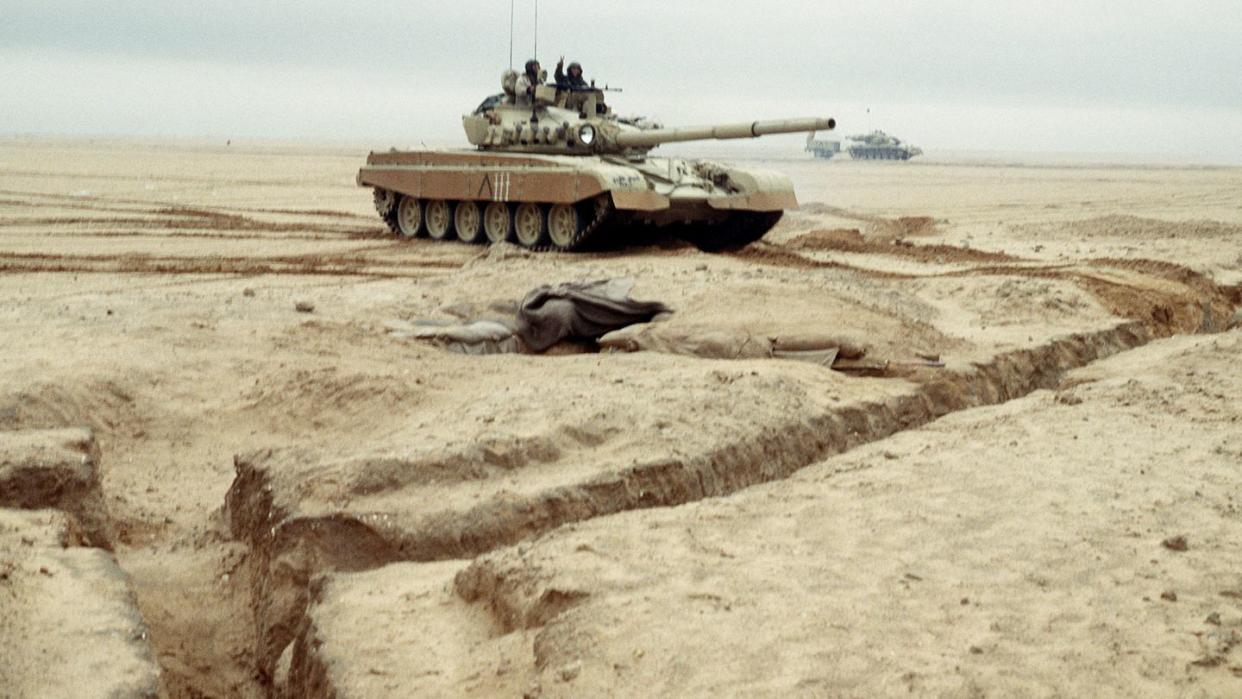
A report on Balkan media claims that Kuwait may have begun transferring some or all of the 149 M-84AB tanks it purchased from the former Yugoslavia back to the Croatian Djuro Djakovic factory where they were first assembled in the 1980s. There, they’ll supposedly receive refurbishing—and possibly upgrades—before going to battle against Russian forces invading Ukraine.
Reports of the arrangement appeared in Serbian media, and six of the tan-colored Kuwaiti M-84ABs have reportedly been seen transported on trailer trucks through Slovenia to Croatia. However, the alleged transfer has not been confirmed by the involved parties.
⚡️It is also reported that 6 M-84/T-72 tanks were spotted at the Barje transfer point in the 🇸🇮Slovenian city of Ljubljana about 4 days ago.
It is worth noting the desert camouflage of the tank, which most likely alludes to Kuwait, which, according to recent rumors, was supposed… pic.twitter.com/e8HAxrfTtp— 🇺🇦Ukrainian Front (@front_ukrainian) January 30, 2024
If the report is accurate, that will be these tanks’ second war to liberate territory from an invading army bent on conquest. In 1991, they were used by exiled Kuwaiti troops to help liberate their country from Iraqi occupation.
The M-84 was Yugoslavia’s license-built take on the Soviet Union’s mainstay T-72 tank. That means it would be relatively easy for Ukraine to integrate into service, as it already operates many different T-72 variants.
A major M-84 transfer could be a shot in the arm for Ukraine’s forces, as deliveries of Western tanks slow down entering the third year of Russia’s full-scale invasion. Furthermore, Kuwait’s M-84AB variant boasts a significantly more powerful engine, tougher armor, and a superior fire control system as compared to early T-72s.
Ironically, in the mid-2010s, Kuwait planned to replace the M-84s (70 of which remained in active units, with the remainder in storage) with new Russian T-90MS tanks. But in 2019, Kuwait “indefinitely postponed” the purchase. For now, Kuwait’s 218 M1A2 Abrams tanks can hold the line, should it sell off the M-84s.
Supposedly, Croatia’s upgrading and donation of the Kuwaiti M-84s will be paid back in kind by Germany, which may transfer 24 Panzer 87 tanks (newly purchased from Switzerland) to Croatia.
Croatia’s Air Force, meanwhile, has also reportedly transferred two Antonov An-32 light cargo planes to Ukraine, which have been in storage at Zagreb’s airport since 2014.
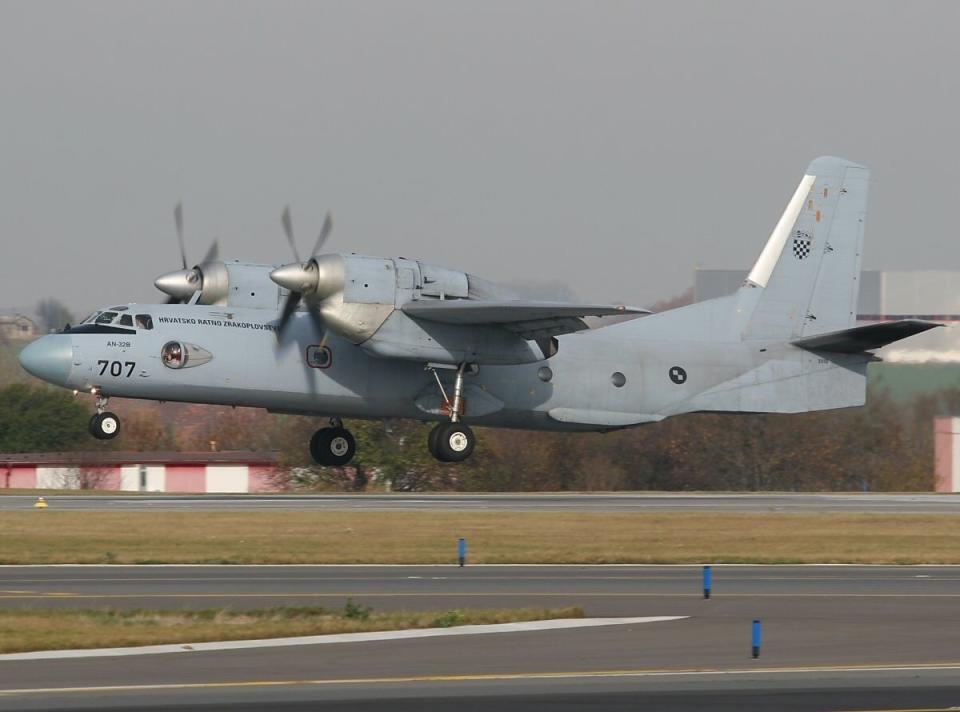
Ukraine’s State Emergency Service was known to operate at least three An-32s. These have likely been busily ferrying aid to Ukraine—and, on one occasion, Turkey, which required earthquake aid in February of 2023. Ukraine will definitely find uses for more of these machines.
M-84: How Yugoslavia’s ‘Super T-72‘ Ended Up in Kuwait
Early in the Cold War, neutral Yugoslavia imported hundreds of Sherman, M47 Patton, T-34/85, and T-55 tanks from both sides of the Iron Curtain. But by the 1970s, Belgrade wanted modern tanks that it could manufacture domestically.
During a 1978 visit to Moscow, Yugoslav President Josip Broz Tito convinced Soviet leader Leonid Brezhnev to sell a license that would allow for the manufacture of the latest Soviet mass-production tank—the T-72—for $39 million. But the legal permissions and schematics still left a lot of legwork for the Yugoslavians to figure out, with their smaller industrial sector.
Ultimately, over 250 companies spread across the Yugoslav Republic contributed components, with final assembly taking place at the Djuro Djakovic factory in Slavonski Brod, Croatia. A prototype T-72MJ vehicle completed in 1983 was followed by 10 pre-production vehicles and mass-production in 1985.
The first series of 370 M-84 tanks had most of the same basic characteristics as the T-72M export tank: a low-profile (2.18 meters high) tank with a three-man crew, a 760-horsepower V46-6 diesel engine, and a powerful (if not especially accurate) 2A46 125-millimeter gun fed by a rotating carousel-style autoloader with 20 rounds and 22 more spares in the crew compartment. All of this was backed up by coaxial and turret-top machine guns, and a 12-shot smoke grenade discharger. While the M-84’s hull used composite materials for enhanced protection, its turret was pure cast steel.
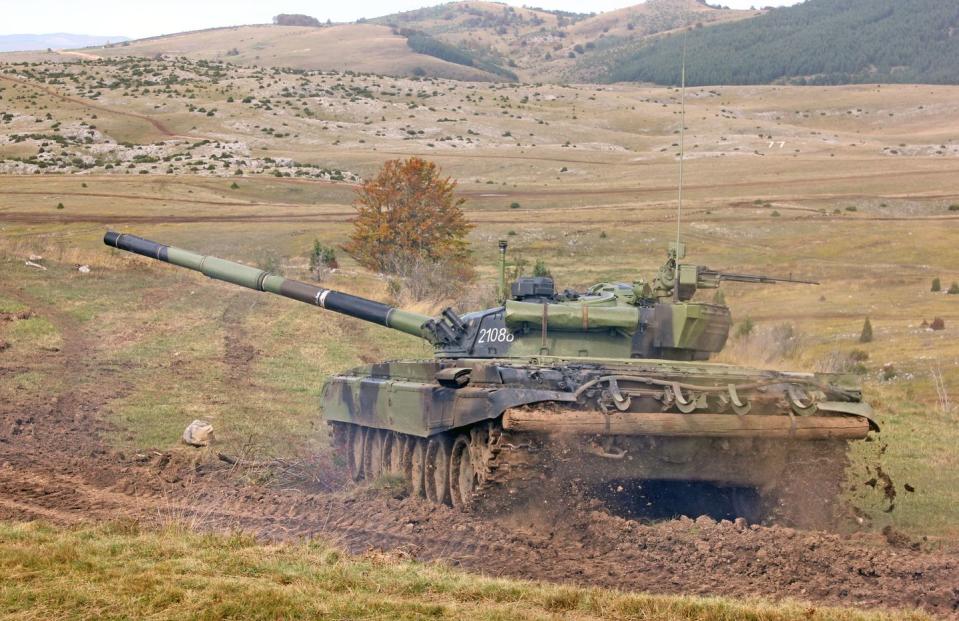
However, the M-84 differed from the original in one critical regard: its superior indigenously developed sensor and fire control system. The gunner’s DNNS-2 sight had a 7x day magnification and 8.5x magnification night vision, and the commander had an independent night sight that could also engage the main gun. The M-84’s fire control computer, meanwhile, was rife with features for its time: a meteorological sensor to account for windspeed and humidity, and computers designed to account for both the movement of the tank and its target.
Adjustments to the improved M-84A model, however, reduced the parts shared with the T-72 to just 40 percent. Protection was significantly enhanced, thanks to the addition of layers of spaced steel and textolite spaced armor, with quartz sand filling the gap between them. That increased the effectiveness of the front armor from the original 380 to 450 millimeters (the higher figure represents defense against shaped charge warheads) to over 700 millimeters RHA equivalent in places. RHA stands for “Rolled Homogenous Armor steel,” and its an effective or equivalent measure of thickness, rather than a literal one.
A more powerful 1,000-horsepower V46-TK engine was also swapped in, bumping maximum speed up from 37 to 45 miles per hour.
Kuwait’s Army was intrigued by the M-84A, and pitted one against an American M1A1 Abrams in desert trials. The Abram’s fuel system broke down, leaving Yugoslavia to win the contract for 200 tanks (including 15 recovery tanks and 15 command tanks) at $1.58 million apiece. Kuwait’s customized M-84ABs had 200 small changes, including different radios, an added searchlight, desert adaptations, and an auxiliary power unit fitted to the M-84ABK command tanks.
The M-84 Tank Goes to War
Depending on how you look at, the Kuwaiti order was either tragically or fortunately too late. Only a handful of M-84As had arrived when Iraq invaded and overran Kuwait in two days, and subsequently paraded the captured factory-fresh tanks.
However, Kuwaiti troops in exile continued to receive dozens of the remaining M-84s. These equipped Kuwait’s 35th Shahid (“Martyrs”) Brigade, which famously held the line against Iraqi tanks in the Battle of the Bridges before withdrawing over the Saudi border. The 35th’s soldiers were trained to operate M-84s by U.S. special forces, as well as Yugoslavian trainers, and fought alongside the U.S. and Saudi troops that liberated Kuwait in the 1991 Persian Gulf War. Two tanks were knocked out, but later repaired. Due to fears they’d be mistaken for Iraqi T-72s, these M-84ABs had three white stripes painted on their side armor as an identification measure, and were employed conservatively.
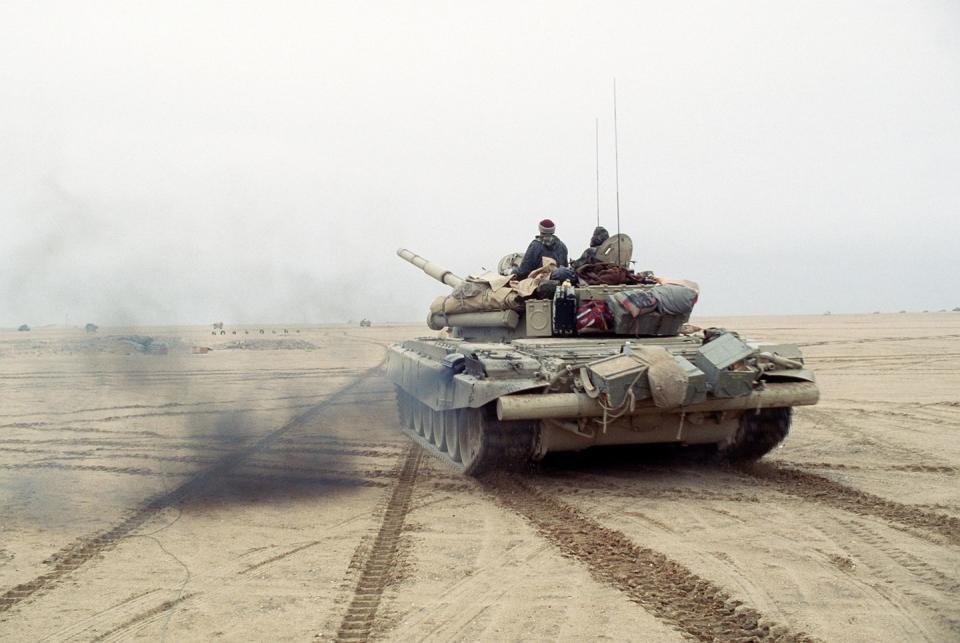
Just a few months after Kuwait’s liberation, ethnic separatism resulted in the violent dissolution of Yugoslavia—interrupting the Kuwaiti order at 150 tanks delivered. The Yugoslav People's Army (usually abbreviated JNA) had seven brigades with M-84s when the war began: three based in Serbia, and one each in Bosnia, Croatia, Slovenia, and North Macedonia. These were soon snatched up by the separating parties alongside older, more numerous T-34s and T-55s.
JNA M-84s were first deployed in the 10 Day War of June/July, 1991—unsuccessfully attempting to stamp out Slovenian independence. Then, from August to November, JNA M-84s battled Croatian national guardsmen in the brutal, three-month-long urban battle of Vukovar. Though the JNA ultimately prevailed, it lost an estimated 100 tanks to ambushing anti-tank teams and mines. Those included around 20 M-84s, four of which were knocked out in a single ambush on Trpinjska Road. However, entrenched JNA M-84s did defeat a counterattack by Croatian T-55 tanks, knocking out three.
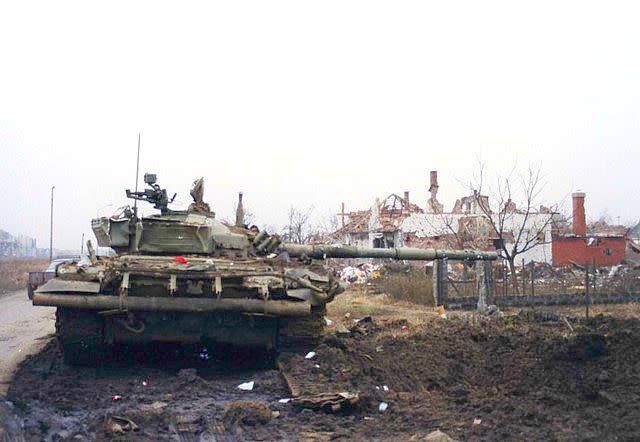
M-84s were also used in the Krajina region by Croatia, and in the Siege of Sarajevo by both Serbian Srpska troops and (in smaller numbers) Bosnian forces. In that theater, with its mountainous terrain, its insufficient gun elevation/depression proved problematic. Chinese HJ-8 anti-tank missiles supplied by Pakistan to Bosnia also proved a threat.

Nonetheless, according to an article by Nikola Isidorovic, the M-84’s front armor was “never penetrated” during the war. Instead, munitions hitting the lower-side armor and mines penetrating the belly armor caused fatal detonations of ammunition stored in the crew compartment, often leading to turret pop-offs—an infamous vulnerability of the T-72 family of tanks. Isidorovic estimates that roughly 40 M-84s were lost by all sides during the five-year civil war, though some proved repairable.
Serbian M-84s latter battled Kosovar separatists from 1998-1999, with nine M-84s lost to the subsequent NATO air campaign. Serbia’s M-84s last saw combat in 2001 in the battle of Oraovice, during the Presevo Valley campaign against Albanian insurgents.
There have been several attempts to market further-upgraded M-84s—most notably, the Croatian M-84D and Serbian M-84AS series, featuring much of the equipment of the Russian T-90A tank (the Shtora active protection system, French Catherine FC thermal sight, and Kontakt explosive reactive armor).
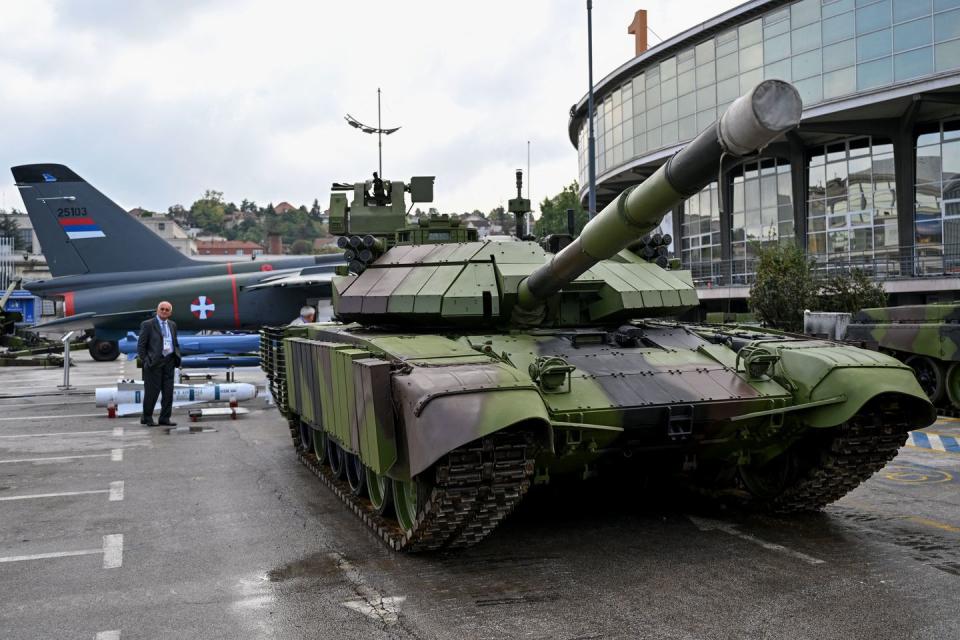
The M-84 Tank and Ukraine
While photographic evidence shows that Russian tank losses outstrip those of Ukraine by a more than 3 to 1 ratio, Russian factories produce several hundred new tanks annually. Presently, Ukraine’s cannot. Thus, sourcing more tanks from abroad is vital to Ukraine—especially those that it can easily integrate into its existing training and maintenance systems. Thus, M-84s from Kuwait—or elsewhere—are undoubtedly of interest to Ukraine and its allies.
Serbia retains roughly 200 M-84s tank in four battalions, and has plans to upgrade at least 40 to the new M-84AS2 model. Meanwhile, Slovenia and Croatia both retain 46 and 74 M-84A4 Snajper (“Sniper”) tanks outfitted with improved Slovenian Omega-84 fire control systems, including improved gun stabilization, better night sights, and new laser range finders. Bosnia and North Macedonia may also have dozens of M-84s in storage.
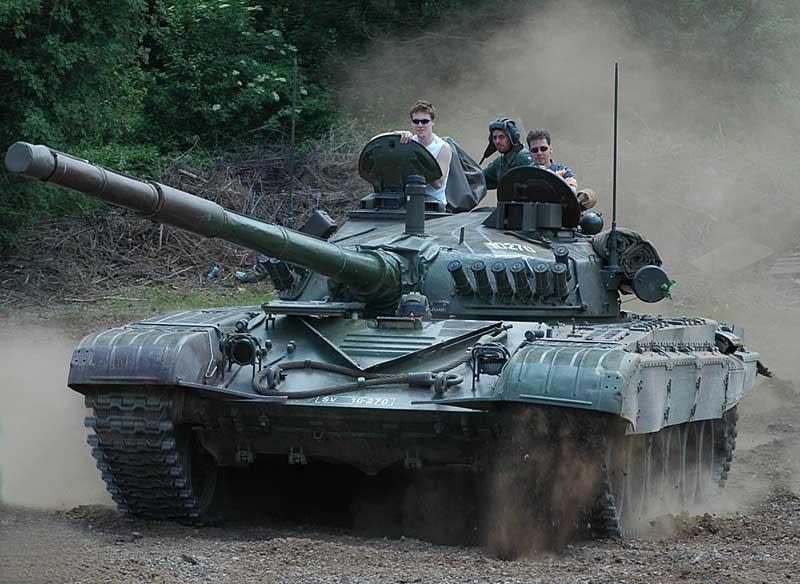
While Serbia is politically unlikely to export tanks for use against Russia, in 2022, it seemed that Ukraine might obtain some or all Slovenia’s M-84A4s (all but 14 of which are in storage). But that fell through, as Slovenia’s leadership was dissatisfied with the promised compensation from Germany.
That could change now that Germany is acquiring Swiss Panzer 87s (ie. Leopard 2A4s) that it could potentially shuffle over to Slovenia or Croatia to compensate for donated vehicles.
If Kuwait’s M-84s are indeed being overhauled in Croatia prior to delivery in Ukraine, it’s worth considering the extent of that process. On the low end, these efforts may simply involve restoring the tanks to useable condition—particularly as 75 of Kuwait’s tanks are reportedly no longer in service. But on the higher end, it’s possible that the M-84ABs could be refitted with the further enhanced fire control systems that were introduced on the M-84A4 Snajper.
Any M-84s entering Ukrainian service will also surely receive explosive reactive armor (ERA) tiles to improve their survivability against shaped-charge armor-piercing weapons (including nearly all infantry anti-tank weapons).
Overall, the Balkan take on the T-72 is a bit tougher, faster, and far-sighted than the original. And, most importantly, significant numbers may become available in what could prove a difficult year for Ukraine, as American military assistance remains stymied by political machinations in Congress.
You Might Also Like

